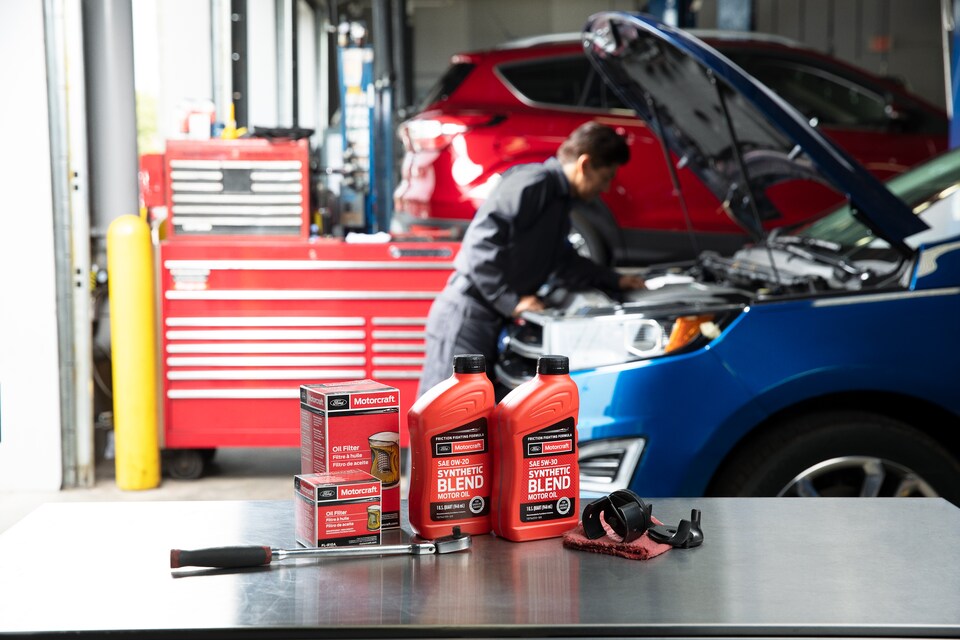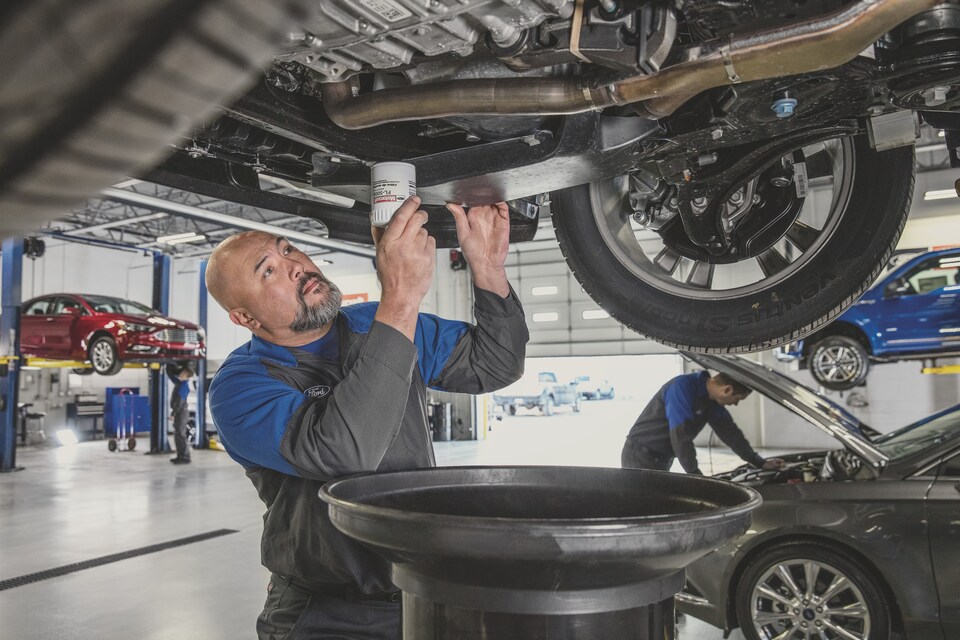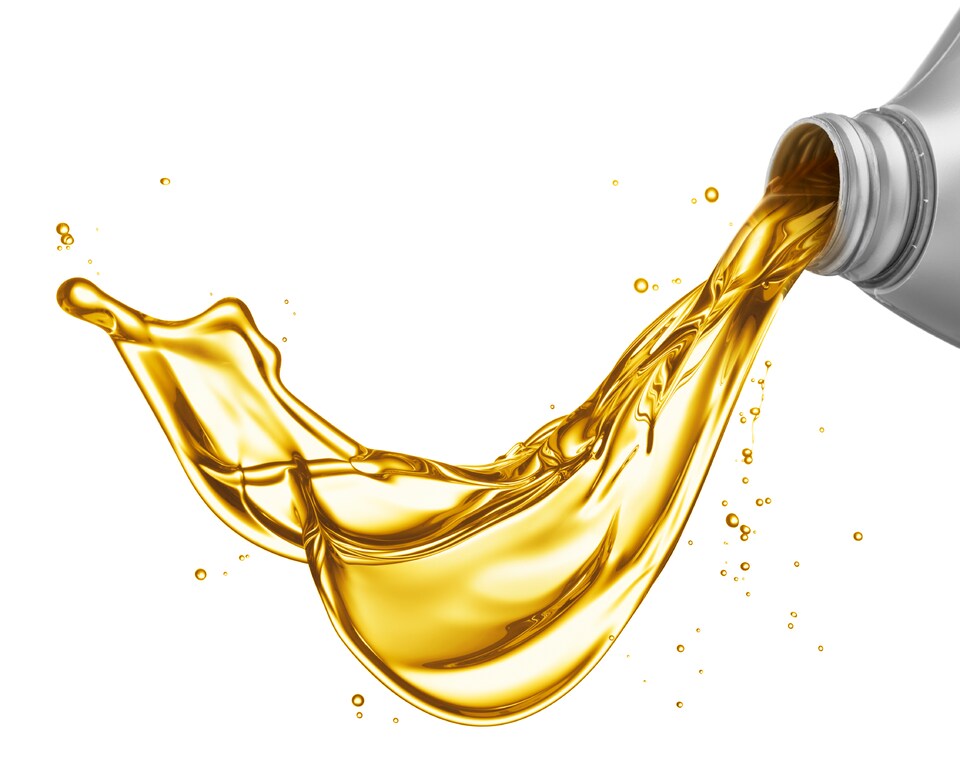Schedule an Oil Change Appointment or Visit Our Quick Lane for No-Appointment Service
Use our online service scheduler to secure a date for an
oil change and the benefits derived from this simple
procedure. If you prefer stopping by without an appointment, you can utilize the Quick Lane service lane offered at Sioux Falls Ford.
Other Frequently Asked Questions About Oil Changes
Still curious to learn more about oil changes? We have the answers to some common questions we get from our Sioux Falls service customers. If you don't see what you're looking for here, feel free to contact our service pros for more info, or come visit our service department in Sioux Falls, SD.
What Is the Role of Oil in Your
Car?
As mentioned above, oil is your car's
lifeblood for optimum performance and longevity. Besides
lubricating the engine's moving parts to reduce friction, it also serves
as a coolant. The oil comes in various types designed for different
engines. Always ensure that you use the correct type of oil recommended
for your engine by the manufacturer. If you have any
doubts, check the manual or the oil cap on the engine for
confirmation.
Besides the type of oil, the
specification also defines the suitable oil viscosity
and necessary additives for lubricating and protecting the
mobile parts of the engine.
Why Is an Oil Change
Necessary?
Car manufacturers and experts recommend
regular changing of motor oil for effective performance. Staying on top
of these changes eliminates the chances of contaminants in the old oil
penetrating the engine and causing severe damage. If you start a
cold engine, there is always a short period with no oil barrier between
the moving parts-the incident results in slight wear.
Moreover, short journeys don't allow the engine to heat up adequately,
which causes the oil to age faster than more extended trips. Depletion
of additives in your engine oil results in some sludge deposits in oil
passages. These deposits reduce
lubrication, making your car susceptible to critical
engine damage.
Thus, dirty and insufficient oil in
your car doesn't just hinder effective performance but also shortens its
lifespan, causing overheating and other severe issues. Besides
decreasing your engine life, old or shallow oil levels bring a risk of
sticking piston rings and overheating. As the moving parts function
during regular operation, heat is produced, and oil acts as a coolant in
such cases.
How Often Should You Change
Your Oil?
Every car manufacturer recommends how often
you should change your oil for the model in the picture. The
recommendation comprises a maximum number of months or miles that you
should cover, after which you should change the oil. For instance, most
vehicles require an oil change after covering between
3000 and 7500 miles or once every six months, whichever comes first.
However,
the recommendations should also serve as a guide rather than a rule. If
your oil levels begin running low before you hit the
set number of miles or period, you should do an instant oil change for
safety. Sadly, most car owners choose to top it up over replacing it,
which is a tremendous risk. Your primary goal isn't only
attaining the proper level but keeping your engine safe from dirt from
the old oil. Working with an expert lets you know the oil's state,
whether it is healthy enough for a top-up or you need a
replacement.
It is also vital to always pay close
attention to your oil change warning light when driving your car. The
light is a sign for shallow oil pressure, and when it comes on, you
should immediately pull over, allow the vehicle to cool, check the oil
level, top it up and get an expert analysis of the
condition.
What Happens Under the Hood During an Oil
Change?
While DIY-ing may be an option during an oil
change, it is advisable to allow an expert to check your car most of the
time. These technicians are experienced at the entire oil change
process, from checking the state and level of the oil to assessing how
great you have been maintaining your car. Eventually, they also make the
necessary recommendations based on their findings. Your vehicle may
need a more intensive inspection if the oil is extremely low or
dirty.
A professional oil change involves draining the
old engine oil and replacing it with a new one. The technicians also
replace the old gunky oil filter with a fresh, lubricated filter for
better performance. As the expert works on the car, they will also
inform you of the type of oil they are using, which is a handy piece of
info for your next oil top-off or DIY oil
change.
Other vital oil change services include
inspection and top off of other car fluids. These fluids include the
windshield washer fluid, automatic transmission fluid, power steering
fluid, and engine coolant. The top-off service for these fluids falls
under the full-service oil change and includes safety checks of the car
battery, hoses, cabin filter, serpentine belt, wiper blades, and tire
pressure. Other packages include lubrication of high-wear auto areas
such as the hood, door hinges, and chassis.
The auto
air filter inspection is a vital part of the oil change service. An
efficient air filter is key to your engine's optimal performance. If it
is dirty and clogged, the technician will change it to save your
engine.
Besides ensuring proper auto
performance and longevity, an oil change also helps assess other
underlying issues, providing instant fixing. Fixing these issues in
their initial stages is cheaper and more convenient than waiting until
you see the symptoms or the car fails while driving
around.
Change Your Oil in Sioux Falls,
SD
Getting a regular oil change for your
car isn't enough to ensure effective auto care and maintenance. It is
also advisable to be cautious about where you schedule
your oil change services. While the cheap independent car
shops along the highway may be tempting, a certified and reputable
dealership is your ideal option. At Sioux Falls Ford, we have the right
tools, technology, and experts to change your car oil. We also provide a
comprehensive checkup on your vehicle to ensure it operates at optimal
performance levels.
The service
center at Sioux Falls Ford can handle more than just oil
changes. Our knowledgeable and friendly technicians have the
right tools and experience to manage an array of your service
needs. So, if your vehicle needs servicing, don't hesitate to contact
us today.


